A New Application in Biology Education: Development and Implementation of Arduino-Supported STEM Activities
Abstract
Simple Summary
Abstract
1. Introduction
Purpose and Significance
- (1)
- How can Arduino-supported STEM activities be designed for the Human Body System topic?
- (2)
- Do the developed Arduino-supported STEM activities have a significant difference in students’ skills for establishing cause-effect relationships?
2. Methodology
2.1. Activity Development Process
- The teacher shortly mentions the relevant subject. Explains the achievements enriched by visuals and videos without detailing (10 min).
- The students are given a knowledge-based life problem for the related outcome, and the students discuss ideas for the solution of the problem among themselves. Students take on their profession and responsibilities (10 min).
- Information from internet-enabled computers, smartphones, and tablets to solve the problem is collected and ideas about what kind of product they will produce are developed by the students They draw the ideas they develop into the idea development notebooks; the teacher checks the drafts (20 min).
- The teacher gives the students the materials they ask for. He/she puts prices on materials. Students take the materials by calculating the cost and create a model of the draft they drew in their idea development notebook (40 min).
- The teacher shares the Arduino codes with the students. Students make the circuit connections of the sensor they will use for Arduino. They check from the computer whether the sensors are working. Students fix the Arduino to their models and give their models their final form (20 min).
- The students select one person among themselves as a representative. The selected person presents his/her model to the class. The teacher scores groups according to the criteria of robustness, timely completion, ability to run the Arduino, cost, and cooperative work. The group with the highest score is rewarded (20 min).
2.2. Arduino Connection
- Arduino software is installed on the computer.
- The project circuit is created on the Arduino board.
- The code screen opens; the codes are written. Previously created codes can also be loaded.
- The codes are loaded.
- The board executes them post-draft.
- It is checked whether the codes are working or not on the serial port screen.
2.3. Circuit Connections
2.4. Validity Study for Activities: Lawshe Technique
- NG = number of experts answering “item is required/appropriate”
- N = Total number of experts delivering opinions
- CVR= [NG/N/2]-1
2.5. Implementation of the Activities
2.6. The Models Student Designed
2.6.1. Skeletal and Muscular System
2.6.2. Digestive System
2.6.3. Circulatory System
2.6.4. Respiratory System
2.6.5. Excretory System
2.7. Data Collection Tools
3. Results
3.1. Results for the Arduino-Supported STEM Activities Students Developed
3.2. Results for the Effects of the Developed Arduino-Supported STEM Activities on Students’ Skills for Establishing a Cause-Effect Relationship
3.3. Evaluation of the Activities
“After doing activities with Arduino, we learned more. For example, we understood how the arduino works and what healthcare professionals, especially doctors, do and experience.”
“In the activities we did with Arduino, I learned the diseases that can happen to people and learned how to develop ideas with sensors in order to find solutions.”
“Team work was very good. Really, our time was so good and we moved forward without ever getting bored.”
“I used to not like science lesson, after this activity, I started to like science lesson, it made me understand the subject better.”
“I used to want to be a teacher. But now I am thinking of becoming a doctor or surgeon.”
“In the past, I wanted to be a translator because I did not know about professions and because I was good at foregin language, now I want to be a scientist or professor.”
- ✓
- they understood the subject better,
- ✓
- they have decided to choose a profession in the field of health in the future,
- ✓
- found the activities fun and efficient,
- ✓
- they liked science lesson more.
4. Discussion
5. Conclusions
Author Contributions
Funding
Institutional Review Board Statement
Informed Consent Statement
Data Availability Statement
Acknowledgments
Conflicts of Interest
Appendix A
Arduino Circuits
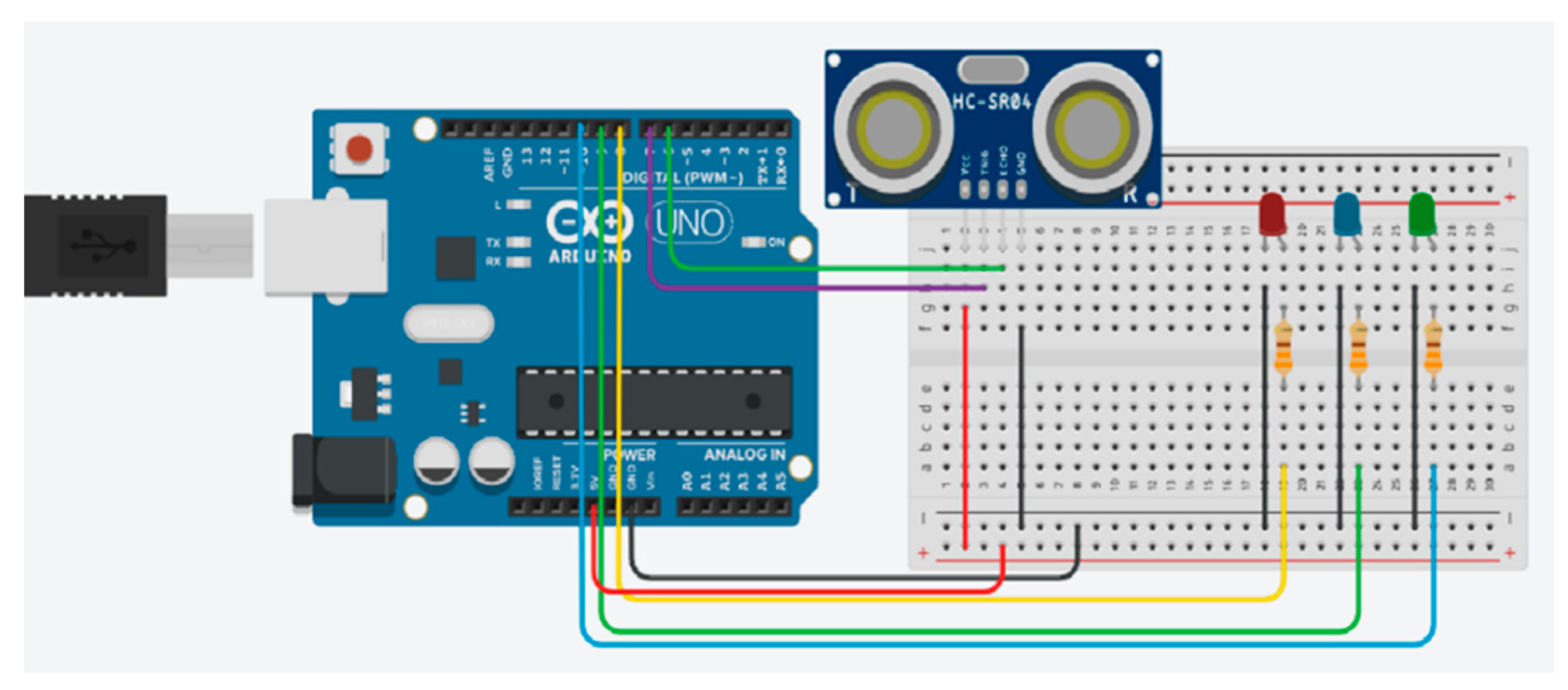
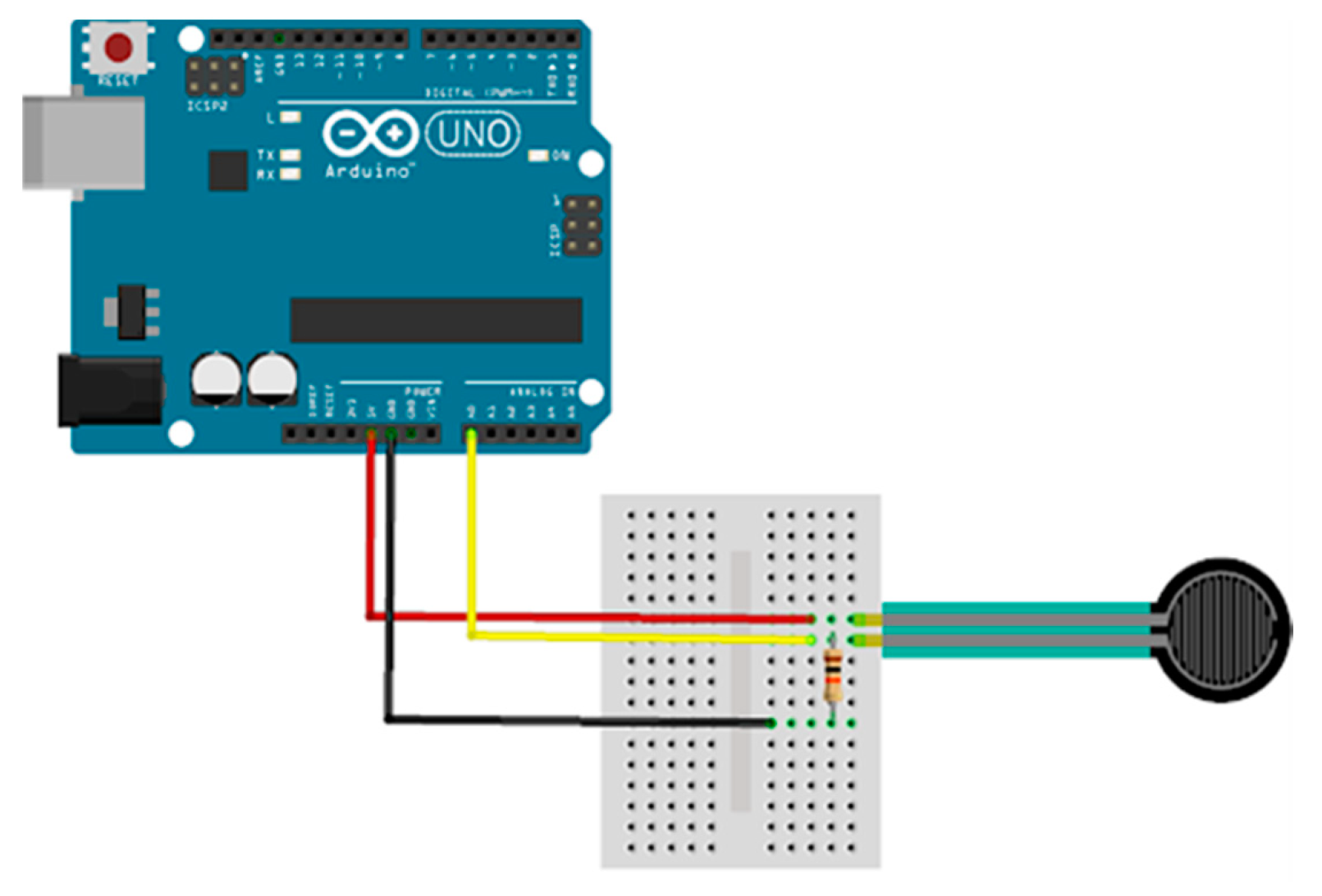
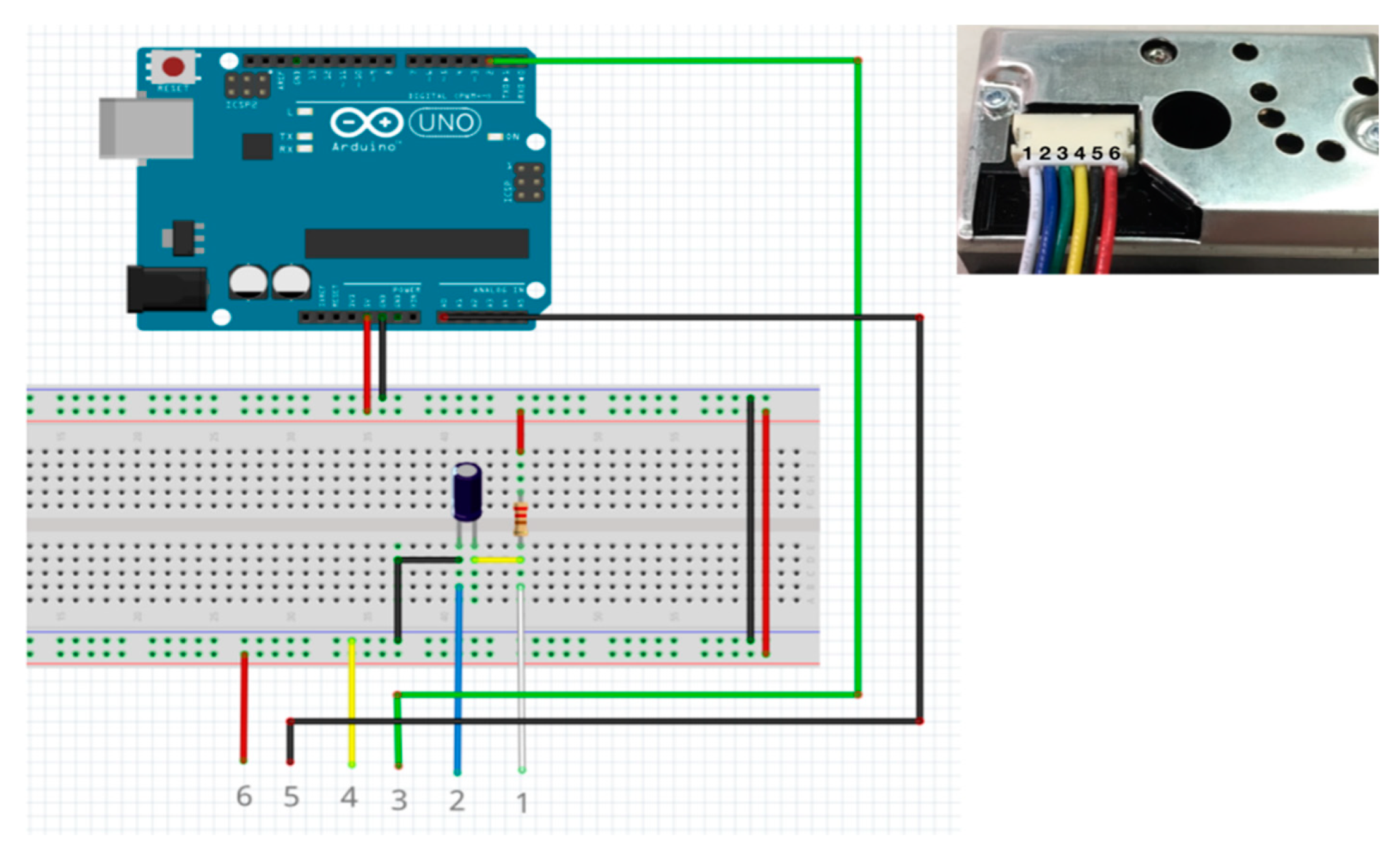
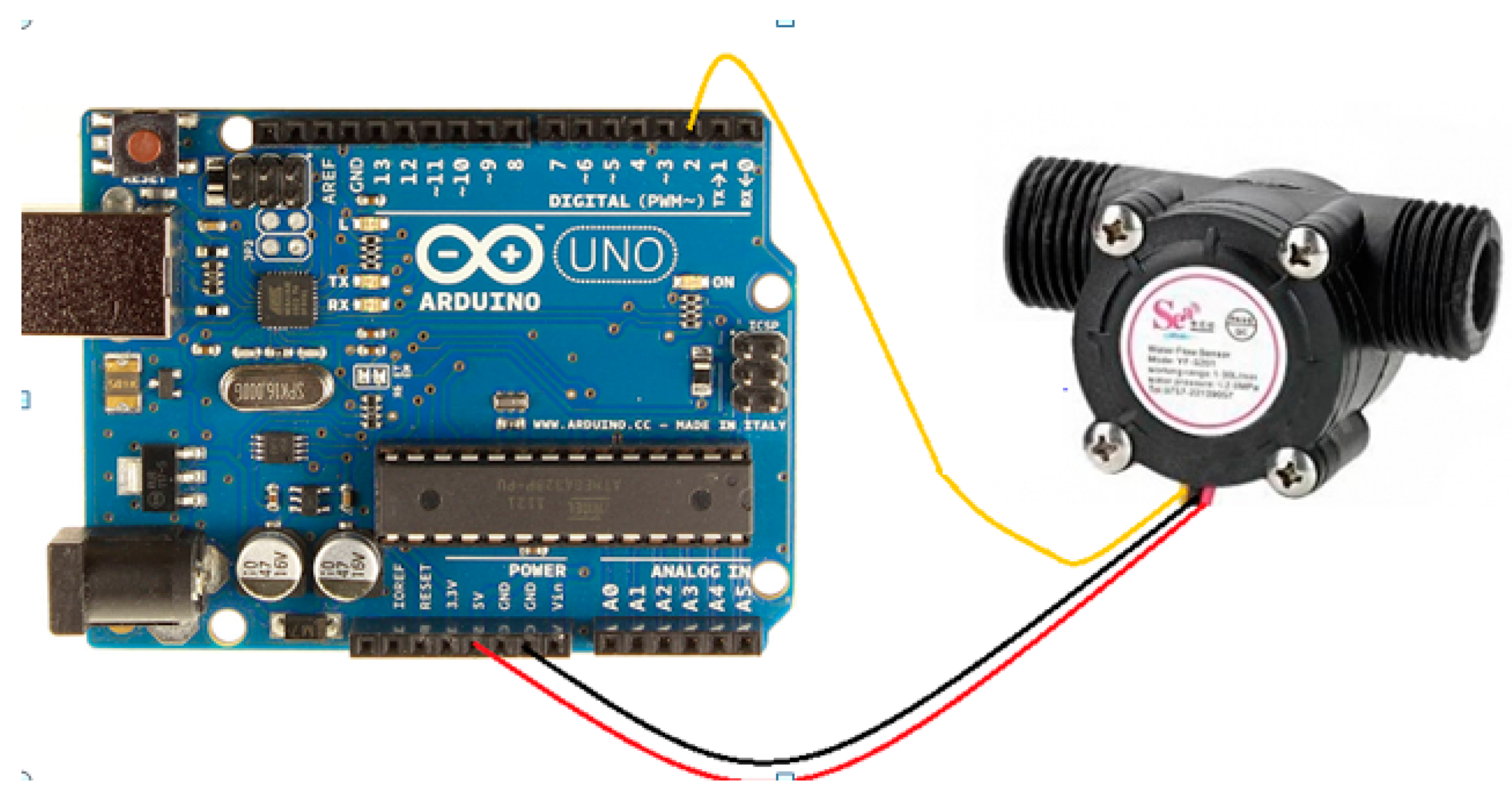
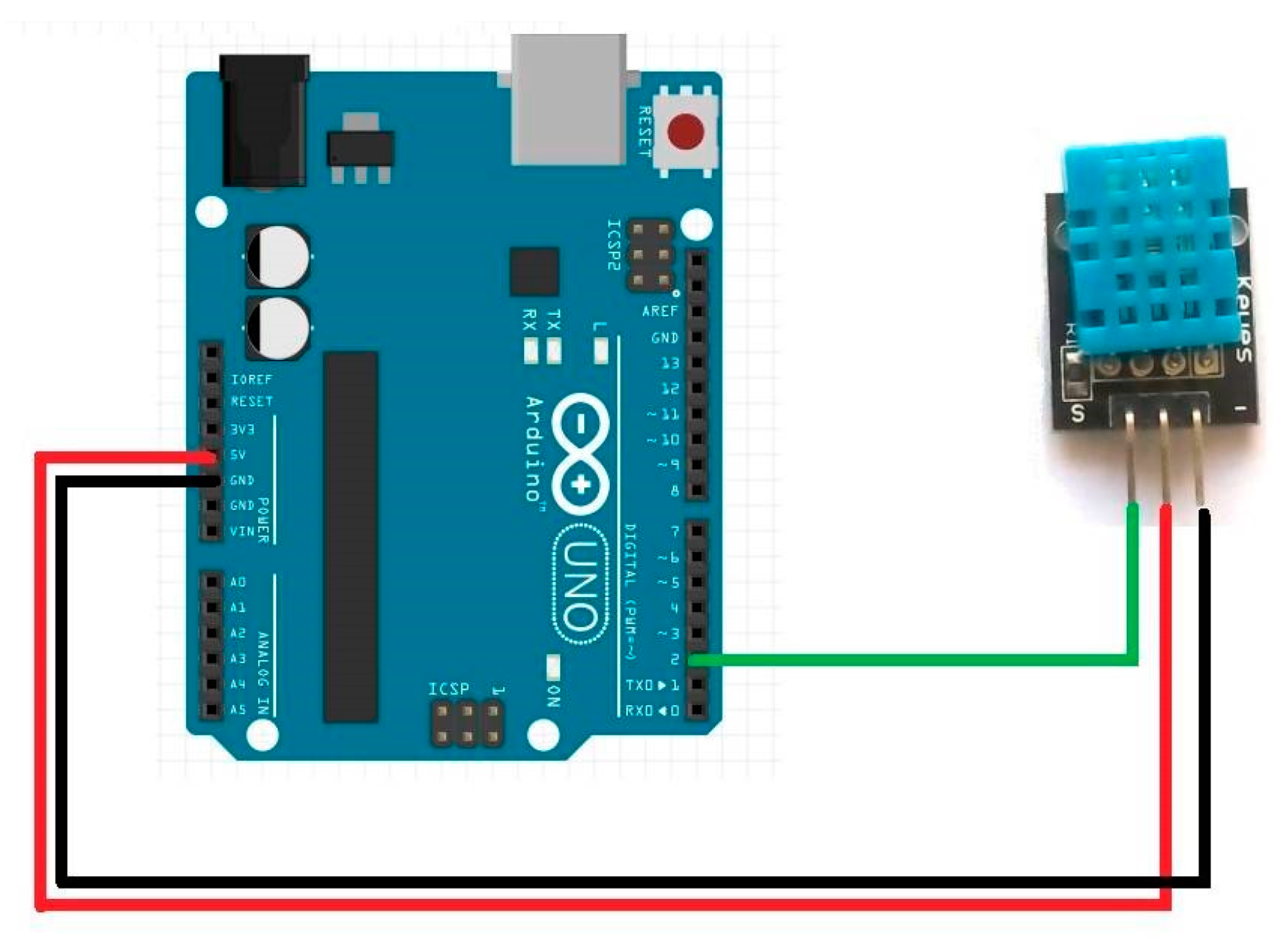
Appendix B
| Bracelet (Distance-Sensor) | Epiglottis (Thin-Film Pressure Sensor) | Pulmonary Circulation (Water Flow Sensor) | Nose (Dust Sensor) | Hand (Humidity Sensor Card) |
|---|---|---|---|---|
| int santimetre; int sure; int trigPin = 7; int echoPin = 6; int mavi = 9; int yesil = 10; int kirmizi = 8; void setup() { pinMode(trigPin, OUTPUT); pinMode(echoPin, INPUT); Serial.begin(9600); } void loop(){ digitalWrite(trigPin, LOW); delayMicroseconds(2); digitalWrite(trigPin, HIGH); delayMicroseconds(10); digitalWrite(trigPin, LOW); sure = pulseIn(echoPin, HIGH); santimetre = (sure/2)/29.1; Serial.print(santimetre); Serial.println("cm"); if(santimetre < 80) { digitalWrite(yesil,HIGH); digitalWrite(mavi,LOW); digitalWrite(kirmizi,LOW); } else if((santimetre > =80) && (santimetre < 120)) { digitalWrite(mavi,HIGH); digitalWrite(yesil,LOW); digitalWrite(kirmizi,LOW); } else if((santimetre > 120)){ digitalWrite(mavi,LOW); digitalWrite(yesil,LOW); digitalWrite(kirmizi,HIGH); } delay(100); } | int fsrPin = A2; int val = 0; int buzzerPin = 8; void setup() { Serial.begin(9600); } void loop() { val = analogRead(fsrPin); Serial.print("Uygulanan Basinc: "); Serial.println(val); if( val > 300){ digitalWrite(buzzerPin, HIGH); delay(100); digitalWrite(buzzerPin, LOW); delay(100); } else{ digitalWrite(buzzerPin, LOW); } } | volatile int flow_frequency; unsigned int l_hour; unsigned char flowsensor = 2; unsigned long currentTime; unsigned long cloopTime; int buzzer = 8; void flow () { flow_frequency++; } void setup() { pinMode(flowsensor, INPUT); pinMode(buzzer,OUTPUT); digitalWrite(flowsensor, HIGH); Serial.begin(9600); attachInterrupt(0, flow, RISING); sei(); currentTime = millis(); cloopTime = currentTime; } void loop () { currentTime = millis(); if(currentTime >= (cloopTime + 1000)) { cloopTime = currentTime; l_hour = (flow_frequency * 60/7.5); flow_frequency = 0; Serial.print(l_hour, DEC); Serial.println(" L "); } if(l_hour > 500){ digitalWrite(buzzerPin, HIGH); delay(100); digitalWrite(buzzerPin, LOW); delay(100); } else{ digitalWrite(buzzerPin, LOW); } } | int measurePin = A0; int buzzerPin = 8; int ledPower = 2; int samplingTime = 280; int deltaTime = 40; int sleepTime = 9680; float voMeasured = 0.0; float calcVoltage = 0.0; float dustDensity = 0.0; void setup(){ Serial.begin(9600); pinMode(ledPower,OUTPUT); } void loop(){ digitalWrite(ledPower,LOW); delayMicroseconds(samplingTime); voMeasured = analogRead(measurePin); delayMicroseconds(deltaTime); digitalWrite(ledPower,HIGH); delayMicroseconds(sleepTime); if(voMeasured >500){ digitalWrite(buzzerPin, HIGH); delay(100); digitalWrite(buzzerPin, LOW); delay(100); } else{ digitalWrite(buzzerPin, LOW); } Serial.print("Okunan Deger: "); Serial.println(voMeasured); delay(1000); } | #include <dht11.h > #define DHT11PIN 2 int buzzerPin = 8; dht11 DHT11; void setup() { Serial.begin(9600); } void loop() { Serial.println(); int chk = DHT11.read(DHT11PIN); Serial.print("Humidity (%): "); Serial.println((float)DHT11.humidity, 2); delay(2000); if( DHT11.humidity > 60){ digitalWrite(buzzerPin, HIGH); delay(100); digitalWrite(buzzerPin, LOW); delay(100); } else{ digitalWrite(buzzerPin, LOW); } } |
References
- Bybee, R. What is STEM education? Science 2010, 329, 996. [Google Scholar] [CrossRef] [PubMed]
- Christopoulos, A.; Pellas, N.; Laakso, M.-J. A Learning Analytics Theoretical Framework for STEM Education Virtual Reality Applications. Educ. Sci. 2020, 10, 317. [Google Scholar] [CrossRef]
- Kelley, T.; Knowles, J. A conceptual framework for integrated STEM education. Int. J. STEM Educ. 2016, 3, 1. [Google Scholar] [CrossRef]
- Li, Y.; Schoenfeld, A.H.; diSessa, A.A.; Grasser, A.C.; Benson, L.C.; English, L.D.; Duschl, R.A. Design and design thinking in STEM education. J. STEM Educ. Res. 2019, 2, 93–104. [Google Scholar] [CrossRef]
- Tan, W.L.; Venema, S.; Gonzalez, R. International Association for Development of the Information Society, Paper presented at the International Association for Development of the Information Society (IADIS). In Proceedings of the 5th International Conference on Educational Technologies, Sydney, Australia, 11–13 December 2017. [Google Scholar]
- Louis, L. Working Principle of Arduino and Using it as a Tool for Study and Research. Int. J. Control Autom. Commun. Syst. 2018, 1, 21–29. [Google Scholar] [CrossRef]
- Zlatanov, N. Arduino and Open Source Computer Hardware and Software. Int. Res. J. Eng. Technol. (IRJET) 2017, 4. [Google Scholar] [CrossRef]
- Banzi, M. Getting Started with Arduino; O’Reilly Media, Inc.: Sebastopol, CA, USA, 2009. [Google Scholar]
- Joynes, C.; Rossignoli, S.; Fenyiwa Amonoo-Kuofi, E. 21st Century Skills: Evidence of Issues in Definition, Demand and Delivery for Development Contexts; K4D Helpdesk Report; Institute of Development Studies: Brighton, UK, 2019. [Google Scholar]
- Hmelo, C.E.; Evensen, D.H. Problem-based learning: Gaining insights on learning interactions through multiple methods of inquiry. In Problem-Based Learning: A Research Perspective on Learning Interactions; Evensen, D.H., Hmelo, C.E., Hmelo-Silver, C.E., Eds.; Routledge: London, UK, 2000; pp. 1–18. ISBN 978-0-8058-2644-9. [Google Scholar]
- Li, Y.; Wang, K.; Xiao, Y.; Froyd, J.E. Research and trends in STEM education: A systematic review of journal publications. IJ STEM Educ. 2020, 7, 11. [Google Scholar] [CrossRef]
- Kerpiç, A.; Bozkurt. An Evaluation of 7th Grade Mathematics Textbook Activities within the Framework of Activity Design and Practice Principles. Mustafa Kemal Univ. J. Soc. Sci. Inst. 2011, 8, 303–318. [Google Scholar]
- Corlu, M.S. [STEM: Integrated Teaching Framework]. In STEM Kuram ve Uygulamalari; Corlu, M.S., Çalli, E., Eds.; Pusula: Istanbul, Turkey, 2017; pp. 1–10. [Google Scholar]
- Lawshe, C.H. A Quantative Approach to Content Validity. Pers. Psychol. 1975, 28, 563–575. [Google Scholar] [CrossRef]
- Yurdugül, H. Using Scope Validity Indexes for Scope Validity in Scale Development Studies. In Proceedings of the XIV. Educational Sciences Congress Pamukkale University Faculty of Education, Denizli, Turkey, 28–30 September 2005. [Google Scholar]
- Veneziano, L.; Hooper, J. A Method for Quantifying Content Validity of Health-Related Questionnaires. Am. J. Health Behav. 1997, 21, S67–S70. [Google Scholar]
- Nuhoğlu, H. Investigation of the Effects of System Dynamics Approach on Attitude, Achievement and Different Skills in Primary School Science and Technology Lesson. Ph.D. Thesis, Gazi University Institute of Educational Sciences, Ankara, Turkey, 2008. [Google Scholar]
- Rosner, B. Fundamentals of Biostatistics, 7th ed.; Cengage learning: Boston, MA, USA, 2010. [Google Scholar]
- Zöhra, B. Sensor Applications with Arduino. 2017. Available online: https://www.researchgate.net/publication/313109058_ARDUINO_ILE_SENSOR_UYGULAMALARI (accessed on 1 June 2021).
- Rinaldi, R.G.; Fauzi, A. A complete damped harmonic oscillator using an Arduino and an Excel spreadsheet. Phys. Educ. 2020, 55, 015024. [Google Scholar]
- Fokides, E.; Papadakis, D.; Kazoullis, V. To drone or not to drone? Results of a pilot study in primary school settings. J. Comput. Educ. 2017, 4, 339–353. [Google Scholar] [CrossRef]
- Pino, H.; Pastor, V.; Grimalt-Álvaro, C.; López, V. Measuring CO2 with an Arduino: Creating a Low-Cost, Pocket-Sized Device with Flexible Applications That Yields Benefits for Students and Schools. J. Chem. Educ. 2018, 96, 377–381. [Google Scholar] [CrossRef]
- Alò, D.; Castillo, A.; Vial, P.M.; Samaniego, H. Low-cost emerging technologies as a tool to support informal environmental education in children from vulnerable public schools of southern Chile. Int. J. Sci. Educ. 2020, 42, 635–655. [Google Scholar] [CrossRef]
- Rusk, F.; Rønning, W. Group work as an arena for learning in STEM education: Negotiations of epistemic relationships. Educ. Inq. 2020, 11, 36–53. [Google Scholar] [CrossRef]
- Çetin, M.; Demircan, H.Ö. Empowering technology and engineering for STEM education through programming robots: A systematic literature review. Early Child Dev. Care 2020, 190, 1323–1335. [Google Scholar] [CrossRef]
- Bellotti, F.; Bottino, R.M.; Fernández-Manjón, B.; Nadolski, R.J. Guest Editorial: Game Based Learning for 21st Century Transferable Skills: Challenges and Opportunities. Educ. Technol. Soc. 2014, 17, 1–2. [Google Scholar]
- Chang, C.-Y.; Kao, C.-H.; Hwang, G.-J.; Lin, F.-H. From experiencing to critical thinking: A contextual game-based learning approach to improving nursing students’ performance in Electrocardiogram training. Educ. Technol. Res. Dev. 2019, 68, 1225–1245. [Google Scholar] [CrossRef]
- Rahman, M. 21st Century Skill “Problem Solving”: Defining the Concept. Asian J. Interdiscip. Res. 2019, 2, 64–74. [Google Scholar] [CrossRef]
- Zhong, L.; Xu, X. Developing real life problem-solving skills through situational design: A pilot study. Educ. Technol. Res. Dev. 2019, 67, 1529–1545. [Google Scholar] [CrossRef]
- Ferdous, T.; Karim, A. Working in Groups outside the Classroom: Affective Challenges and Probable Solutions. Int. J. Instr. 2019, 12, 341–358. [Google Scholar] [CrossRef]
- Stehle, S.M.; Peters-Burton, E.E. Developing student 21st Century skills in selected exemplary inclusive STEM high schools. Int. J. STEM Educ. 2019, 6, 1–15. [Google Scholar] [CrossRef]
- Aldowah, H.; Al-Samarraie, H.; Fauzy, W.M. Educational data mining and learning analytics for 21st century higher education: A review and synthesis. Telemat. Inform. 2019, 37, 13–49. [Google Scholar] [CrossRef]
- Sarican, G.; Akgunduz, D. The impact of integrated STEM education on academic achievement, reflective thinking skills towards problem solving and permanence in learning in science education. Cypriot J. Educ. Sci. 2018, 13, 94–107. [Google Scholar] [CrossRef]
- Vennix, J.; den Brok, P.; Taconis, R. Do outreach activities in secondary STEM education motivate students and improve their attitudes towards STEM? Int. J. Sci. Educ. 2018, 40, 1263–1283. [Google Scholar] [CrossRef]
- Putri, F.S.; Istiyono, E. The Development of Performance Assessment of Stem-Based Critical Thinking Skill in the High School Physics Lessons. Int. J. Environ. Sci. Educ. 2017, 12, 1269–1281. [Google Scholar]
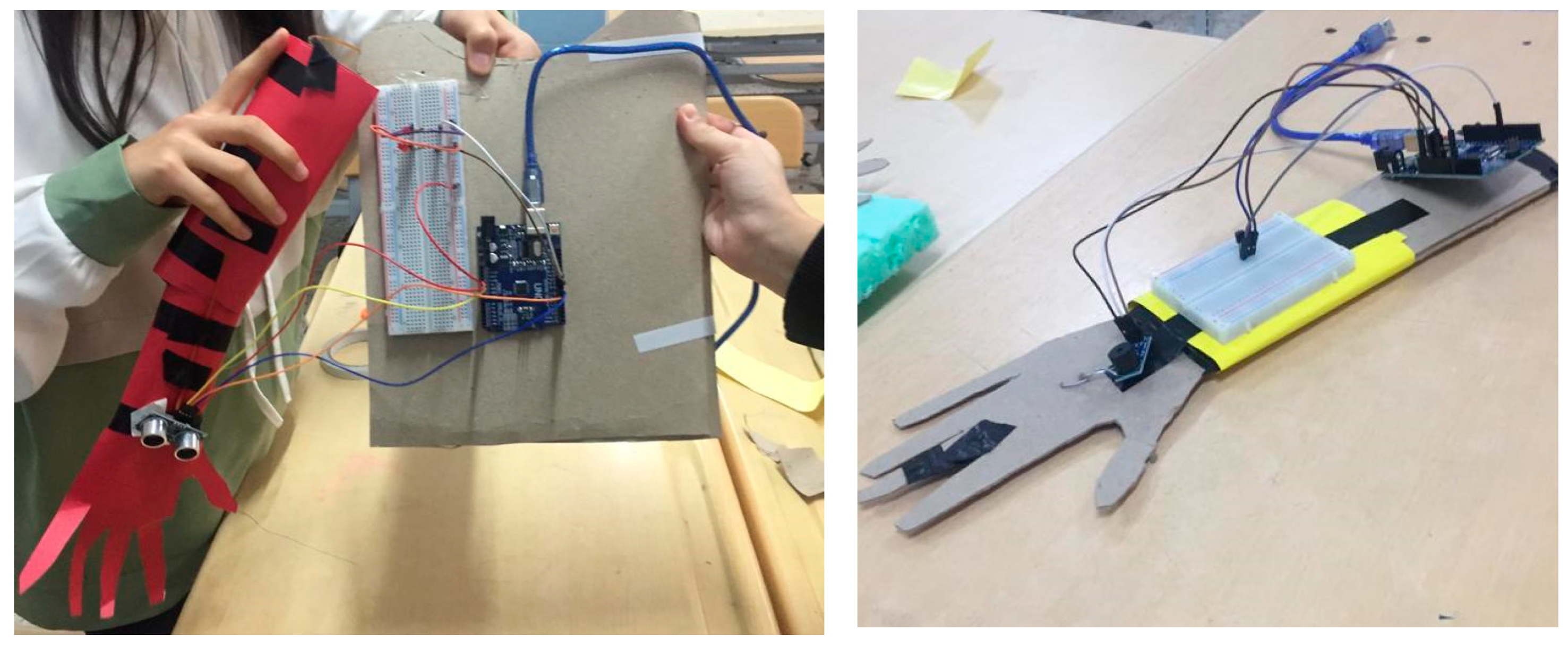
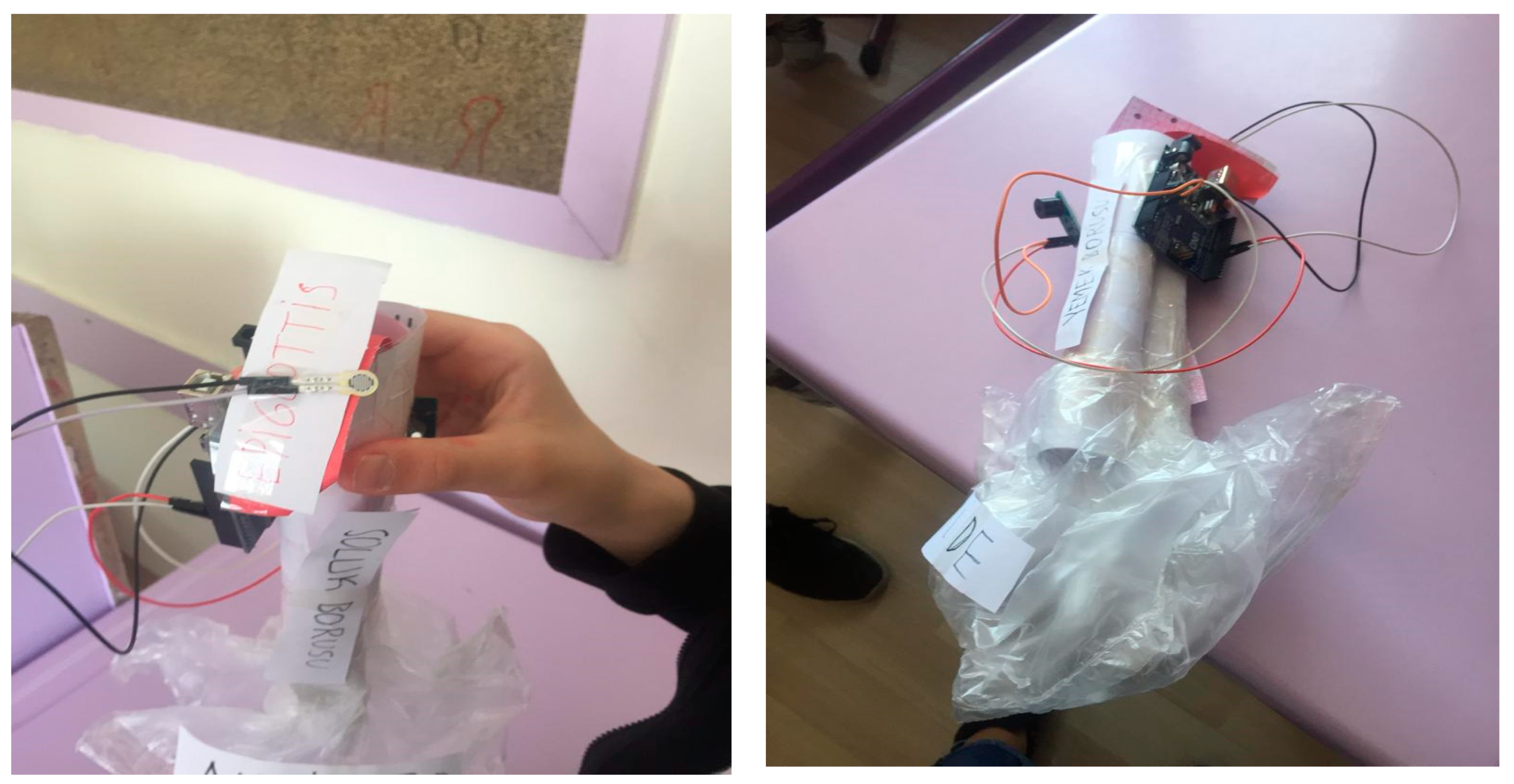
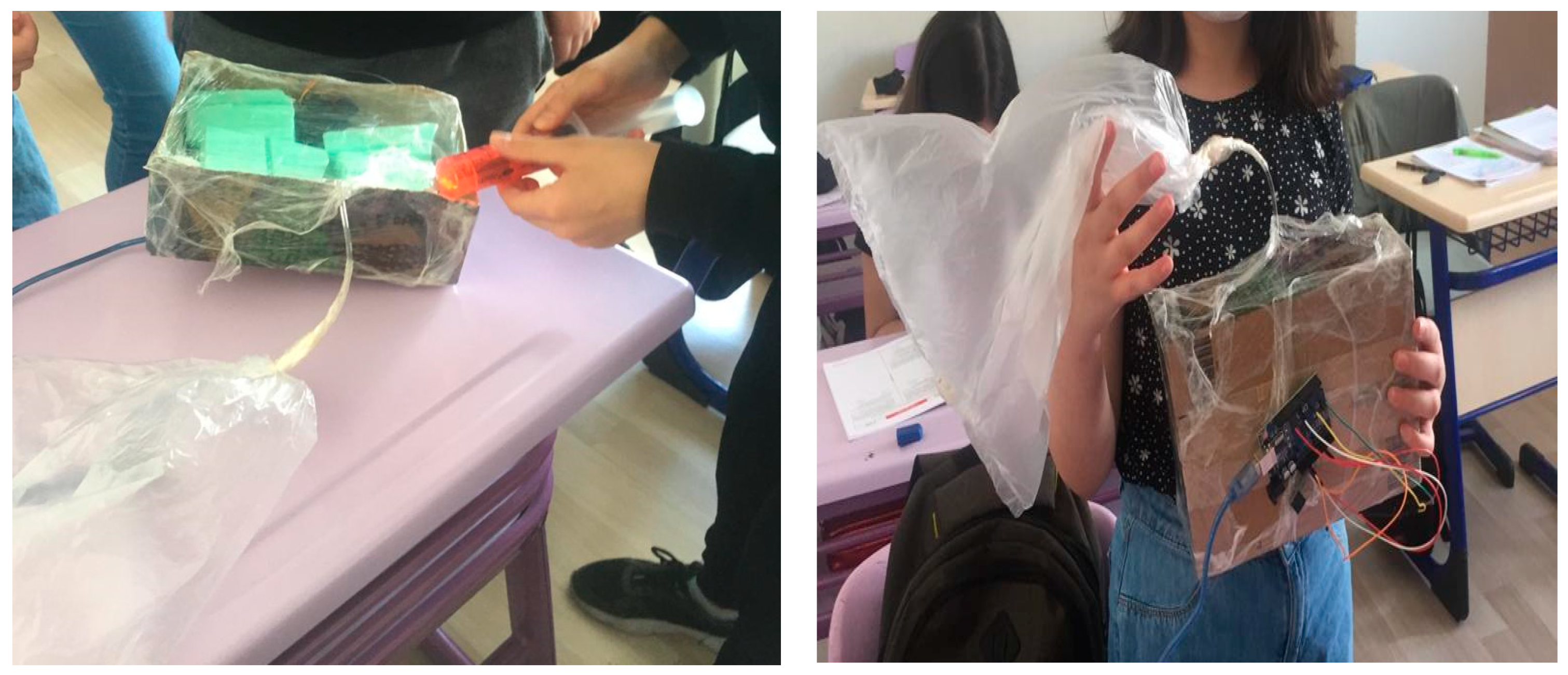
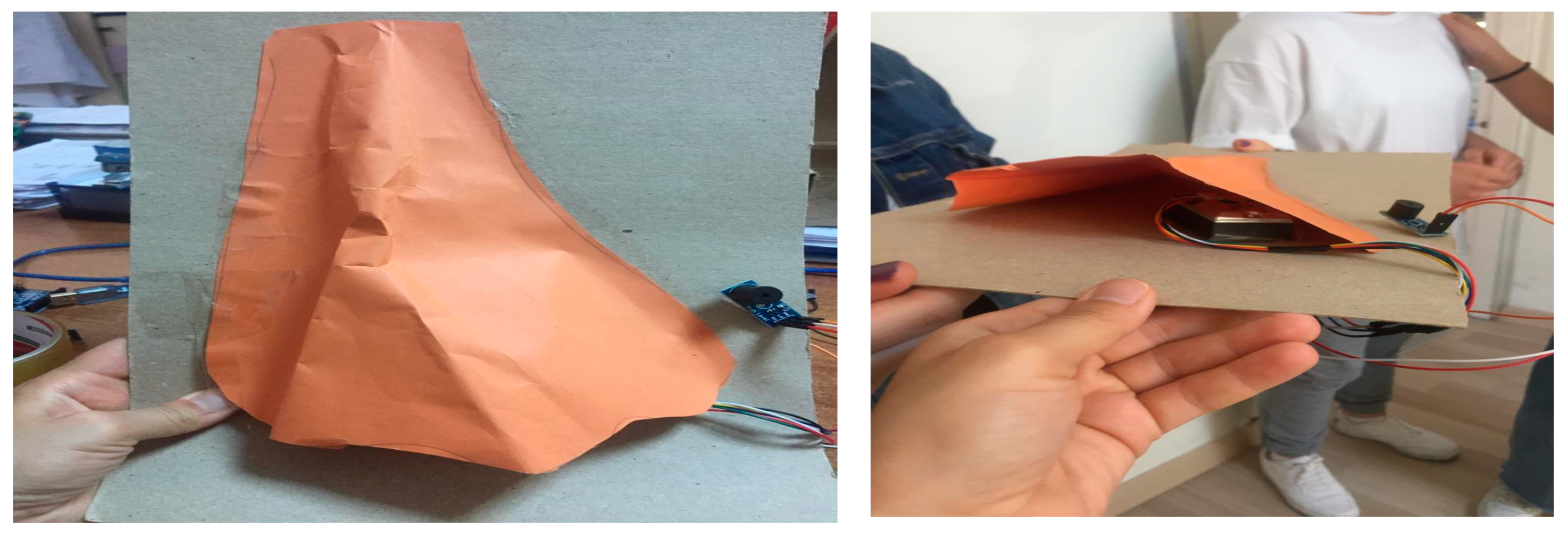
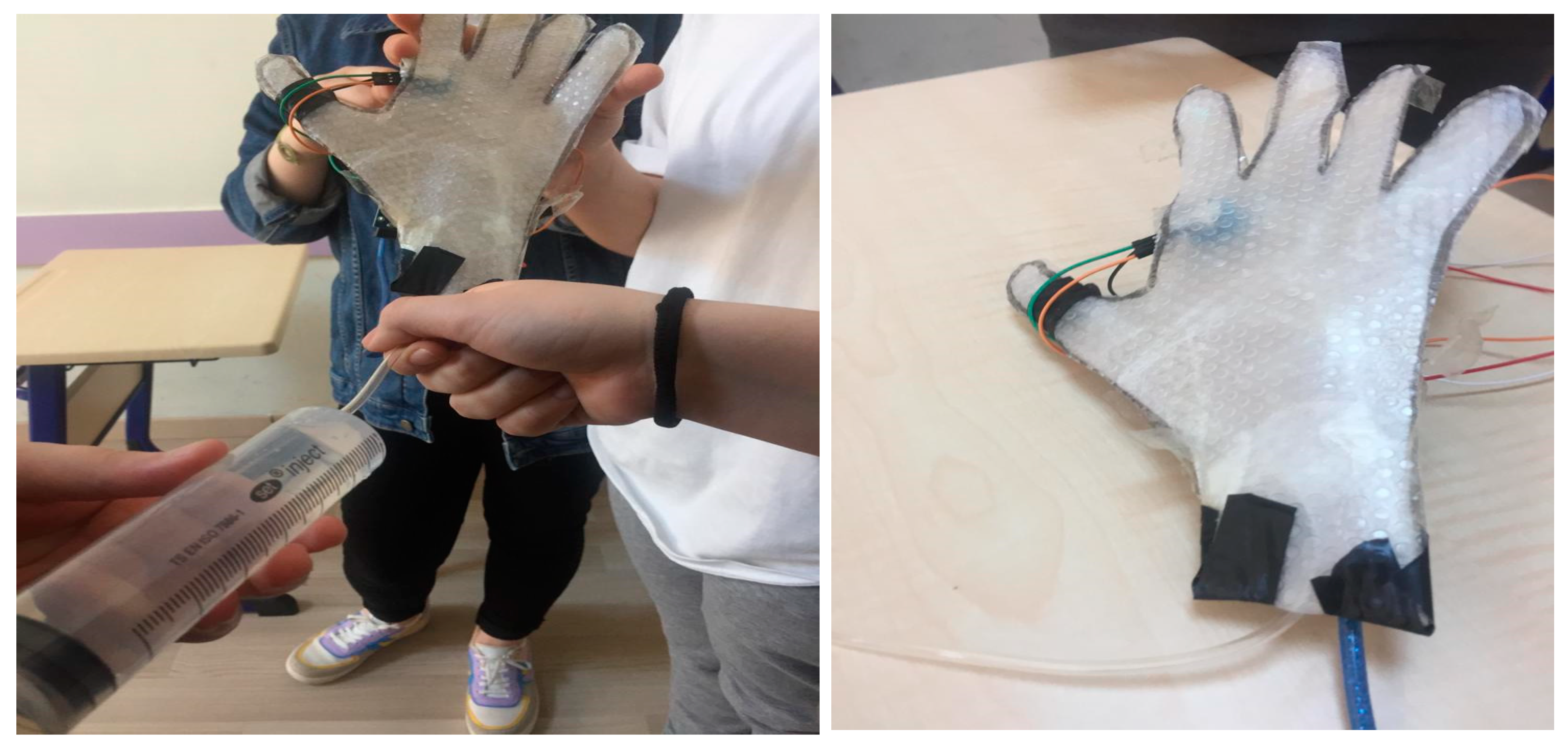
| Teacher Role | Student Role |
|---|---|
|
|
| Duration (min.) | Lesson 1 | Lesson 2 | Lesson 3 |
|---|---|---|---|
| 10 | Obtaining Information | Modeling | Arduino Connection |
| 10 | Task Distribution | ||
| 10 | Developing Ideas | Presentation | |
| 10 |
| Subject | Science | Engineering | Mathematic | Technology | Social Product |
|---|---|---|---|---|---|
| Skeletal and muscular system (distance-sensitive bracelet model) | Explains the structures of the skeletal and muscular system with examples. | Identifies the processes involved in an engineering project. Explains the stages such as planning, prototyping, design, execution, quality control, and reporting. Predicts the performance, reliability, and failure status of alternative solutions. Investigates the principles and elements of design. | Compares and orders objects by length Selects and measures the appropriate non-standard measuring tool to measure a length Creates and draws structures by using shapes and models. Measures lengths in meters or centimeters using standard tools Draws a segment with a given length using a ruler. | Realizes that computers can be used for different purposes. Uses information technology tools to do research. Does simple research on the Internet Collects data about a problem Understands data collection with Arduino and how to use sensors. | Communicates effectively with groupmates and shares ideas Can transform his/her imagination into a drawing Participates actively in group work The student presents the designed product to the class in an intelligible manner. |
| Digestive system (pressure-sensitive epiglottis model) | Explains the functions of the structures and organs that make up the digestive system using models. | ||||
| The circulatory system (pulmonary blood circulation model) | Explains the functions of structures and organs that make up the circulatory system using a model. | ||||
| The respiratory system (dust-sensitive nose model) | Explains the functions of the structures and organs that make up the respiratory system using models. | ||||
| Excretory system (moisture-sensitive hand model) | Summarizes their functions by showing the structures and organs that make up the excretory system on models. |
| Time | Activity |
|---|---|
| 1st week | Cause-Effect Relationship Scale pre-test implementationv Introduction of Arduino and sensors to be used in events |
| 2nd week | Skeletal and muscular system (Distance-sensitive bracelet model) |
| 3rd week | Digestive system (Pressure-sensitive epiglottis model) |
| 4th week | The circulatory system (Liquid flow-sensitive pulmonary blood circulation model) |
| 5th week | The respiratory system (Dust-sensitive nose model) |
| 6th week | Excretory system (Moisture-sensitive hand model) |
| 7th week | General review of human body systems subject Cause-Effect Relationship Scale post-test application |
| Groups | N | x− | S | U | p |
|---|---|---|---|---|---|
| Control Group | 9 | 27.00 | 1.05 | 43.500 | 0.069 |
| Treatment Group | 10 | 31.90 | 5.48 |
| Groups | N | Pre-Test | Post-Test | Z | p | ||
|---|---|---|---|---|---|---|---|
| x− | SS | x− | SS | ||||
| Control Group | 9 | 27.00 | 6.38 | 31.11 | 1.05 | −2.675 | 0.069 |
| Treatment Group | 10 | 31.90 | 4.38 | 39.50 | 5.48 | −2.374 | 0.018 * |
Publisher’s Note: MDPI stays neutral with regard to jurisdictional claims in published maps and institutional affiliations. |
© 2021 by the authors. Licensee MDPI, Basel, Switzerland. This article is an open access article distributed under the terms and conditions of the Creative Commons Attribution (CC BY) license (https://creativecommons.org/licenses/by/4.0/).
Share and Cite
Görgülü Arı, A.; Meço, G. A New Application in Biology Education: Development and Implementation of Arduino-Supported STEM Activities. Biology 2021, 10, 506. https://doi.org/10.3390/biology10060506
Görgülü Arı A, Meço G. A New Application in Biology Education: Development and Implementation of Arduino-Supported STEM Activities. Biology. 2021; 10(6):506. https://doi.org/10.3390/biology10060506
Chicago/Turabian StyleGörgülü Arı, Aslı, and Gülsüm Meço. 2021. "A New Application in Biology Education: Development and Implementation of Arduino-Supported STEM Activities" Biology 10, no. 6: 506. https://doi.org/10.3390/biology10060506
APA StyleGörgülü Arı, A., & Meço, G. (2021). A New Application in Biology Education: Development and Implementation of Arduino-Supported STEM Activities. Biology, 10(6), 506. https://doi.org/10.3390/biology10060506







